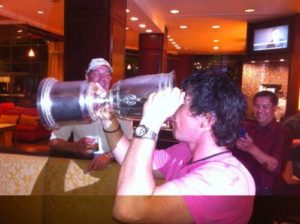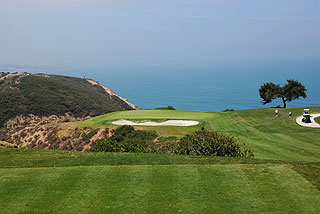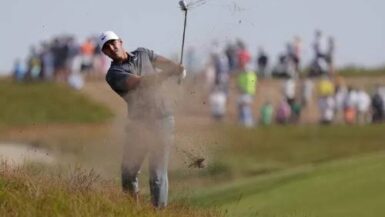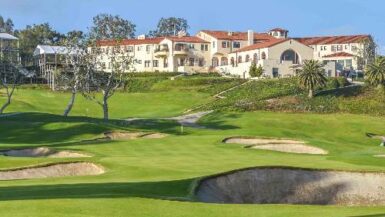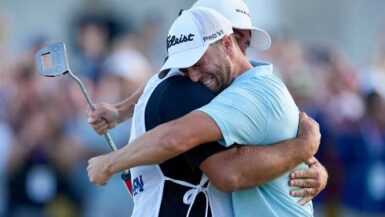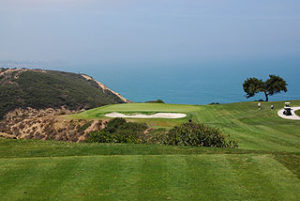
As one of my mentors once wrote, “If you’re gonna write about the U.S. Open, you have to be well-versed in the lore of Francis Ouimet’s knickers.”
He was right. It’s important to have sense of history watching this, the 121st edition of America’s national championship of golf. So pay attention. There won’t be a quiz, but the knowledge comes in handy so that we can all keep a perspective on just how historic something may or may not be. We’ll also revisit a few cool U.S. Open anniversaries and meet some colorful characters from golden ages long past.
Even Martians know that the active player with the most U.S. Open titles in Tiger Woods with three, but he’s not in the field this week. He’s home recovering from leg surgery because he drives golf balls much better than he drives cars.
Woods won his first U.S. Open at Pebble Beach in 2000, where he shattered nearly every major scoring record, including lowest score to par (12-under) and margin of victory (15 shots, prompting Ernie Els to grouse, “if he does that St. Andrews, there ought to be an inquiry”).
Woods also won U.S. Opens at Bethpage Black in 2002 and – as you may have heard – here at Torrey in 2008. You’ll recall that year Tiger “won the Open on one leg” after Tanya Harding’s boyfriend smashed Tiger’s knee with a cricket bat…or maybe he got hit by a Greyhound bus…or maybe he was saving airplane full of babies from a volcano. The story gets wilder every time, depending on which broadcaster is pontificating. Still it was amazing theatre.
Brooks Koepka, the PGA Tour’s current alpha predator, is next among the active players with two U.S. Opens, back-to-back wins in 2017 (Erin Hills in Wisconsin) and 2018 (Shinnecock Hills on Long Island).
That’s an astounding feat that neither Jack Nicklaus nor Tiger Woods ever accomplished. Curtis Strange went back-to-back in 1988 at The Country Club (Brookline, Mass, site of next year’s U.S. Open) and in 1989 at Oak Hill in Rochester. Strange won that Brookline U.S. Open by filleting Nick Faldo in a playoff, 71-75. The immortal Ben Hogan went back to back in 1950 and 1951 at Merion and Oakland Hills. Those victories were not just important historically, they were downright heroic. Hogan was hit by a Greyhound bus for real, and playing golf post-accident was nothing short of a Herculean effort to him. Hot baths in Epsom salts, long, tight stockings, and pain PAIN PAIN were his daily routine. Hogan had already won an Open in 1948, so when he came to Merion, all the talk was could he win another major.
You see? Even then they thought, they’d never see another like him…but there’s always the next phenom…
Anyway, they made a movie about Hogan’s triumph at Merion called Follow the Sun. Hogan returned for an encore at Oakland Hills the following year, winning again at another quintessential Open venue, one I hope they will return to soon and often. That was the year the USGA first instructed Robert Trent Jones, Sr. to turn their championship venue into Castle Dracula. It took Hogan, a man as icy-veined as Van Helsing himself, to “bring this Monster to its knees.”
Not for nothing, but author Dan Jenkins hints in his memoirs that actual quote was “this bastard to its knees,” but they couldn’t print that back then.
The only other fellows who went back-to-back were Ralph Guldahl, Bobby Jones, and John McDermott. Guldahl won twice in a row in 1938 and 1939 at Oakland Hills and Cherry Hills. Jones, as you well know, won four U.S. Opens, as did Nicklaus, Hogan and Willie Anderson. Jones went back-to-back in 1929 at Winged Foot West and in 1930 at Interlachen, another wondrous Donald Ross gem in Minnesota.
Before that, you’d have to go all the way back to 1911 when a 19 year-old McDermott became the youngest winner and first American born U.S. Open winner at Chicago Golf Club, and then repeated in 1912 at Country Club of Buffalo. Still the youngest winner to date, he is among eight players age 21 or younger who have won the U.S. Open.
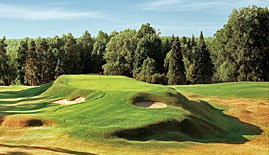
But getting back to Koepka, he shares a scoring record with Rory McIlroy. They both eclipsed Woods’s Pebble Beach mark, posting 16-under. Rory also still owns several scoring records from that 2011 Open at Congressional, including the 54-hole mark and lowest aggregate of 268. Rory is, of course, in the field as is 2014 winner, Germany’s Martin Kaymer, holder of the record for lowest opening 36 holes, 65-65-130 at Pinehurst No. 2.
Defending champion Bryson DeChambeau holds the honor of being the player with the opportunity to repeat, and he may well do it. This PGA Tour layout is well known to him, and he even expects to blast driver over much of the trouble.
“I’ll try to be as aggressive as possible. I feel like it’s a little bit similar to Winged Foot,” DeChambeau stated magisterically. “For the most part, I’m going to be trying to bomb it as much as possible and try to gouge it out when I don’t hit it in the fairway.”
Dustin Johnson (2016 at Oakmont), Justin Rose (2013 at Merion’s East Course), Webb Simpson (2012 at Olympic Club’s Lake Course), Jordan Spieth (2015 at Chambers Bay), and Gary Woodland (2019 at Pebble Beach) round out the list of former U.S. Open champions in the field. Among them only Spieth is a multiple major winner, bagging a Masters and an Open Championship at Royal Birkdale.
There are several important anniversaries to celebrate this year:
***1901*** The aforementioned Willie Anderson won his first of four U.S. Opens at Myopia Hunt Club. (I invited a friend of mine there once, but he was too chicken to go on the fox hunt afterwards.)
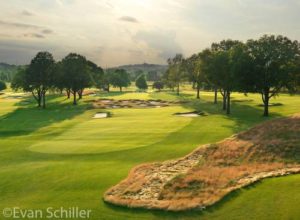
***1906*** Philadelphia Cricket Club, the oldest country club in America hosted the first of its two U.S. Opens on their nine-hole St. Martin’s Course. Look for their Wissahickon Course, an A.W. Tillinghast masterpiece brilliantly renovated by Keith Foster to host the USGA Fourball and maybe even a future Philadelphia U.S. Open.
***1911*** McDermott wins the first of his back-to-back Opens in Chicago.
***1916*** Fabled amateur Chick Evans went wire-to-wire at a Minnesota Donald Ross masterpiece called Minikhada.
***1926** Bobby Jones wins the second of his four U.S. Opens at Ohio’s Scioto Country Club. The Golf Gods, having an impeccable sense of history fated Scioto to also produce the greatest golfer ever to play the game, Jack Nicklaus.
***1931*** Billy Burke beats George Von Elm in a 72-hole playoff at Inverness in Ohio. Do not adjust your set, you read that correctly: there were two 36-hole playoffs. That settled that; the USGA moved to 18 the following year. Meanwhile Burke smoked as total of 32 cigars during the tournament, using the wafting rings to gage the wind direction.
***1946*** WWII vet and three-time purple heart recipient Lloyd Mangrum defeats Byron Nelson and Vic Ghezzi in a playoff at Canterbury. Mangrum injured landing at Normandy, fighting at the Battle of the Bulge, and again when a jeep overturned on him. Henceforth I always remember him as “Lloyd Mangled.”
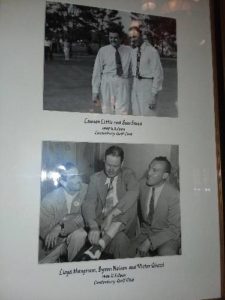
***1951*** Hogan’s second of two consecutive at Oakland Hills
***1966*** Arnold Palmer loses a seven shot lead with nine holes to play at Olympic Club to fall into a playoff with Billy Casper, then loses the playoff the next day after leading that through nine holes as well. Palmer only won one U.S. Open, the 1960 Open at Cherry Hills where he closed with a 65.
***1971*** Using a rubber snake his daughter slipped inhis golf bag that morning, Lee Trevino plays comedian with Jack Nicklaus as the straight man, defeating him in a playoff for the Open title at Merion. Just three weeks later, Trevino stole another trophy from Nicklaus at the Open Championship at Royal Birkdale, chipping in an astounding five times and holing out once from the fairway to edge Nicklaus and an odd little fellow known only in golf history as “Mr. Lu” by a shot.
***1986*** The Open returns to Shinnecock Hills after a 90 year absence. Ray Floyd breaks out of a nine player logjam at the start of the back nine to take home his only U.S. Open champions medal.

***2006*** Oakmont reveals its restored look with the forest of member-planted trees finally removed and bringing that critical maintenance practice to the mainstream. “You can grow trees, or you can grow grass,” has always been true, but it was hearing that “you can continue to have a course worthy to host an Open or not…” that finally woke the members from their tree-hugging lethargy. Everyone agrees, the course hasn’t looked this good or played this well in many decades, and Oakmont is still the measuring stick other courses use to measure themselves. Few if any, match up to the challenge.
***2011*** Many of Rory McIlroy’s scoring records are still his. And he is still in his prime and is certainly among the favorites this week.
“The game of golf is in a really great place right now,” McIlroy noted cheerfully in his interview this morning. “Sure there’s some things some of us nerds might not want to change, but from a whole, looking at the entirety of it, I think golf has grown and is in a great place.”
